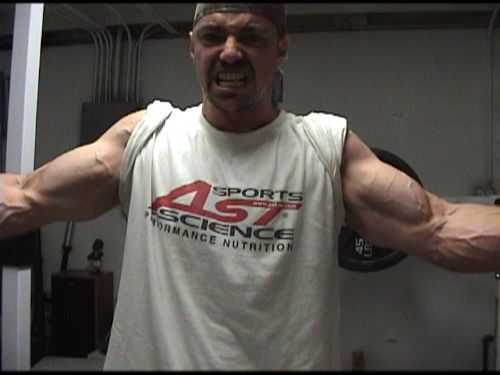Everybody has them but nobody wants them. What are they? Stubborn, hard-to-develop muscle groups. For me, it’s shoulders, calves and biceps. For you, it may be chest and triceps or perhaps hamstrings and quadriceps. No matter what the part, the solution to it remains the same: specialization!
Specialization is a technique that provides highly-targeted training overload to one or more muscle groups. This can be in the form of additional training volume and/or training frequency, i.e. do more sets for it and/or train it more often. Just like medical doctors specialize in certain areas of medicine, you will learn how to specialize on a particular muscle group and excel with it.
I’m going to show you a particular specialization program that I’ve found to be EXTREMELY useful for developing stubborn muscle group. It’s not hard to do and it doesn’t take long to do but it has the potential to shatter plateaus in hard-to-develop muscle groups like a brick through a plate glass window.
How To Do Daily Specialization
The name of the program is Daily Specialization and, as the name implies, it’s done on a daily basis. In a nutshell, you will do just 1 set of 1 exercise for 1 muscle group twice a day, every day. It’s very simple but very powerful and it can be done with any muscle group you like!
I will use dips as an example here but you can use any exercise you like. Choose an exercise you can do at home for your selected muscle group to make it easier and more convenient to do (chances are, you’re not going to be going to the gym twice a day to do 1 set of 1 exercise!).
If you have weights at home, it will broaden your selection but I find that bodyweight exercises (that use your bodyweight for resistance, e.g. dips, chin-ups, push-ups, etc.) are most effective.
Using dips as the example, on Day 1, very soon after you wake up, do as many dips as you can. Go to failure, doing as many reps as you can then stop. That’s your morning workout. You’re done.
Do everything else in your day as you normally would, even your regular workouts for that muscle group if they’re on your schedule. This program exists completely outside your regular workout schedule.
At night before you go to bed, do another set of dips to failure. That’s it. When you wake up the next day, do another set of dips to failure, just like on Day 1. Keep this up for as long as you like – anywhere from a few weeks to a few months, depending on the results you want and whether you want to switch to another muscle group or not.
This is the entire program! As a quick note, you can add a third set in the middle of the day on non-training days in order to speed results. It will give your body a little extra stimulus for that muscle group. Also, do only one muscle group at a time with this program. If you add in more parts, you will dilute the training stress and diminish the effects of the program.
The key to success with this program is consistency. You MUST do it consistently every day, twice a day, without fail to provide that constant training stimulus to the body. Even if you don’t feel like it, do it. Even if you’re tired and you don’t get nearly as many reps as usual, do it. Even if your muscles are sore, do it. The only exception to this rule is if you’re sick or injured. Do this, and you WILL get results.

How to Do Daily Specialization With Free Weight Exercises
With THIS version, you will use an exercise that allows you to increase the resistance by small amounts on a regular basis.
You will still do an exercise to failure for one set twice a day, but rather than using the same resistance every time (as with bodyweight exercises), we will force even greater adaptation by increasing the resistance slowly but steadily.
Ideally, you’ll want to have a way to increase the resistance easily, such as using a barbell or dumbbells. If you don’t have barbells or dumbbells at home, you still have options for increasing resistance while using bodyweight exercises, such as:
- You can change body positions in ways that make the exercise harder. For example, if you’re using Bench Dips and you start with your knees bent 90 degrees and your feet flat on the floor, you will move your feet further away from the bench, then set them up on a chair/bench, then place them on something that is higher than what your hands are setting on.
- The other way to easily add resistance to a bodyweight exercise is to get yourself a sturdy backpack and gradually load it with heavy objects such as books or water bottles filled with sand. The more heavy things you put in the pack, the more resistance you’ll get.
For the first 4 days, start with a resistance that allows you to get around 10 to 15 reps for your one set. Your body will rapidly start adapting to this new stress. You may experience some initial soreness from working your muscles far more frequently than they’re used to. Four days should be enough time to allow your body to effectively start adapting.
Now we’re going to start adding resistance, realizing the full power of incremental progressive resistance. Increase the resistance by the smallest amount you can and keep the twice-daily schedule going.
Add 2 1/2 lb plates to your barbells/dumbbells. Shift your body position a small amount if using a bodyweight exercise. Add one heavy book to your backpack, etc.
Use this resistance for at least 2 days to allow your body time to adapt to the slightly higher workload. After 2 days on this resistance level, note how many reps you’re able to do with that weight. If your reps are 5 or less on this resistance, stay at that weight for one more day. This will be your rule of thumb for increasing resistance levels.
From this point on, your goal is to increase the resistance you are using very slightly every 2 days. Follow the 5 rep rule of thumb where if your reps are 5 or less, use that resistance for one more day. As well, continue to stay at that resistance for as long as your reps stay below 5 or less. Don’t reduce the weight, just add days on until you can do more than 5 reps with it.

Over the course of weeks and months, you are going to force some serious adaptation in your target muscle group.
This small but continuous increase in resistance, which allows your body a chance to adapt and focus on it, can result in extremely large strength increases and add plenty of muscle mass to your target muscle group.
The best exercises to use with this type of training are the basics – the exercises that use the most muscle for your target muscle group. This could be Barbell: bench presses, curls, deadlifts, presses overhead, rows & weighted dips, etc. Good bodyweight exercises include pull-ups, dips, bench dips, push-ups, etc.
I’m a big fan of having some basic training equipment at home, even if it’s just a set of adjustable dumbbells, and I highly recommend investing in those if you’d like to try this program. Sporting goods stores or garage sales are your best bets for free weights (don’t order online as you will be hit with HUGE shipping charges). Weights at home are not absolutely necessary but they definitely help!
If and when you do try this program, be sure to keep track of your resistance levels and muscle group measurements so you can gauge exactly how effective the program is for you.
Why Daily Specialization Training Works
Physiologically speaking, the body becomes its function. If you run long distances, your body will have a tendency to become smaller and lighter to be better able to cope with the stress. If you lift weights, your body will have a tendency to become more muscular in order to deal with the resistance.
We target this highly-efficient adaptation process by training stubborn muscle groups with very high frequency. Your body quickly learns it needs to build up that muscle group in response to this constant workload. Your body will very quickly start allocating recovery resources towards rebuilding that part bigger and stronger.
You keep working it and your body will keep building it. This program harnesses the adaptive power of your body and channels it into a specific muscle group for maximum results. The results are consistent and phenomenal!
You also get incredible nervous system “practice” using this technique. Because you’re performing a single exercise with very high frequency, your nervous system becomes very adept at the exercise, learning the exact best activation pattern. Strength gains come through muscle AND through nervous system learning with this technique.
Let me give you my experience with Daily Specialization. I used this program for my shoulders, doing handstand push-ups. At a bodyweight of 200 pounds, when I started I couldn’t do a single full rep, only a few partial reps.
After 12 weeks of consistently doing handstand push-ups morning and night, I was able to perform 40 full reps at the very same bodyweight. If you think about this for a moment, it’s actually quite shocking! Could you imagine barely being able to bench press your bodyweight one day then, 3 months later, being able to press it 40 times!
The results came little by little but on a consistent and daily basis. Over the 3 months (which were going to go by anyway, regardless of whether I did this program or not) this resulted in HUGE gains in muscle development and also carried over to strength in exercises such as shoulder press and bench press.
You can easily achieve powerful results like this with the Daily Specialization Program.

One of the greatest benefits I found with this program wasn’t even the improvement in strength and muscle development. Working the stubborn muscle group twice a day to failure actually made my stubborn shoulders not stubborn anymore!
The constant workload, in addition to building strength and muscle mass, also greatly increased the circulation/capillarization in the muscles. Poor blood circulation is one of the biggest causes of lagging muscle development. This greatly-improved circulation meant more nutrients could get into the muscles more easily, which means easier muscle growth in the long-term.
Not a bad result for a few minutes of effort every day!
And if you’re worried about overtraining and getting weaker, don’t be. Yes, you will be training with very high frequency, and yes you won’t be achieving complete recovery between training sessions but here’s the thing…the volume is VERY low. Just one set. Within a few days, your body will get the idea and start getting very efficient at channeling recovery resources to that worked muscle group. Your recovery window will decrease and your strength and muscle development will take off!
What Arnold Knew About Building Muscle
That No other Bodybuilder Did at the Time
By Nick Nilsson






